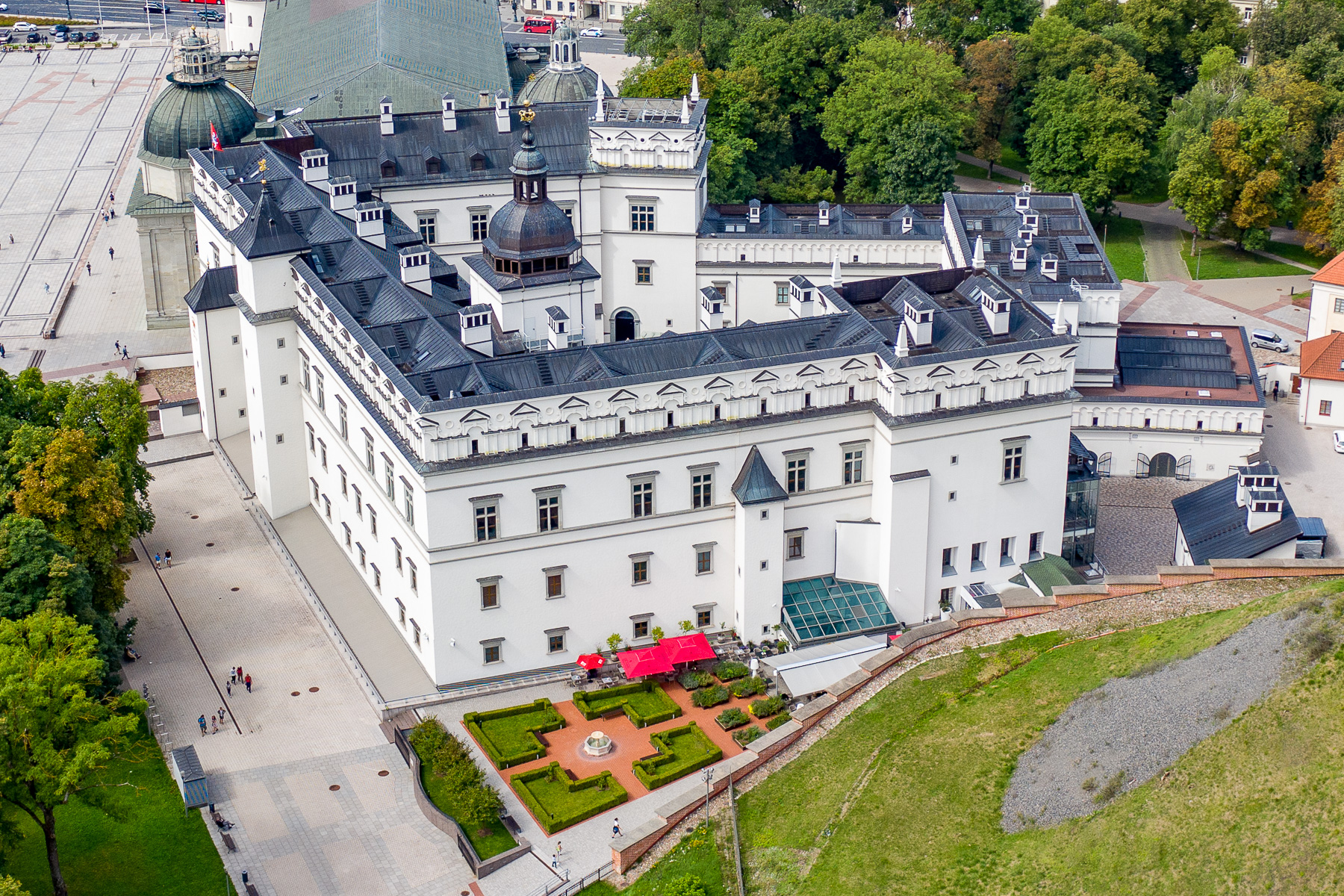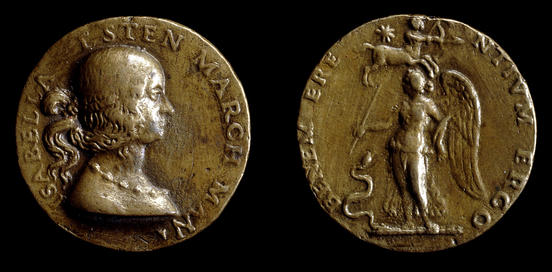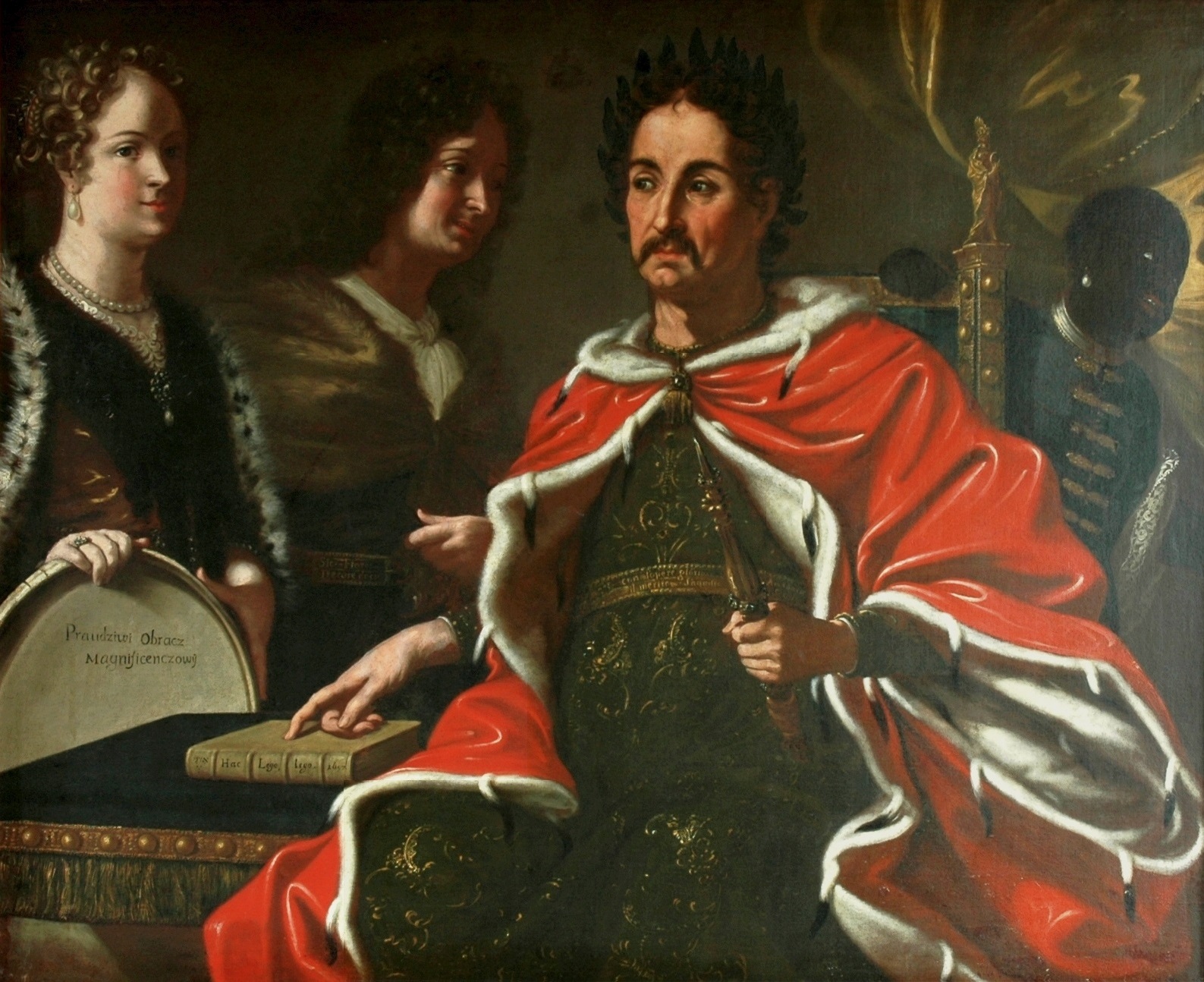|
Marie Casimire D'Arquien
Marie Casimire Louise de La Grange d'Arquien (, ; 28 June 1641 – 30 January 1716), known also by the diminutive form "Marysieńka", was a French noblewoman who became the queen consort of Poland and grand duchess consort of Lithuania from 1674 to 1696 by her marriage to King and Grand Duke John III Sobieski of the Polish–Lithuanian Commonwealth. She had great influence upon the affairs of state with the approval of her spouse, and acted in effect as regent during his absence. Early life Marie Casimire and her sister Louise Marie were the only surviving children of Henri de la Grange, Marquis d'Arquien and his first wife, Francoise de la Chastre (1613-1648). She came to Poland at the age of five years as a lady in waiting to Marie Louise Gonzaga, the French-born Queen of Poland and Grand Duchess of Lithuania from 1645 to 1672, wife and consort to two Polish kings and Lithuanian grand dukes — Władysław IV Vasa and later his brother (who succeeded him) John II Casimir Vasa ... [...More Info...] [...Related Items...] OR: [Wikipedia] [Google] [Baidu] |
Battle Of Vienna
The Battle of Vienna took place at Kahlenberg Mountain near Vienna on 1683 after the city had been besieged by the Ottoman Empire for two months. The battle was fought by the Holy Roman Empire (led by the Habsburg monarchy) and the Polish–Lithuanian Commonwealth, both under the command of King John III Sobieski, against the Ottomans and their vassal and tributary states. The battle marked the first time the Commonwealth and the Holy Roman Empire had cooperated militarily against the Ottomans. The defeat was a turning point for Ottoman expansion into Europe, after which they would gain no further ground. In the ensuing war that lasted until 1699, the Ottomans would cede most of Ottoman Hungary to Leopold I, Holy Roman Emperor. The battle was won by the combined forces of the Holy Roman Empire and the Polish–Lithuanian Commonwealth, the latter represented only by the forces of the Crown of the Kingdom of Poland (the march of the Lithuanian army was delayed, and they reached ... [...More Info...] [...Related Items...] OR: [Wikipedia] [Google] [Baidu] |
Grand Duke Of Lithuania
This is a list of Lithuanian monarchs who ruled Lithuania from its inception until the fall of the Grand Duchy of Lithuania in 1795. The Lithuanian monarch bore the title of Grand duke, Grand Duke, with the exception of Mindaugas, who was crowned king in 1253. Other Lithuanian rulers, such as Vytautas the Great, also attempted to secure a royal coronation, but these efforts were unsuccessful.Nadveckė, Ineta (6 July 2019Trys Lietuvos karaliai: vienas tikras, vienas nelabai ir vienas beveik''Lithuanian National Radio and Television, LRT''. Until 1569, the Lithuanian monarchy was hereditary. In 1386, Grand Duke Jogaila was elected King of Poland. From that point onward, with some interruptions, the two states were united in a personal union, sharing a common ruler until 1569, when they were formally merged by the Union of Lublin to form the Polish–Lithuanian Commonwealth. The monarch of this new state was elected in a free election by the entire nobility. From the Christianizat ... [...More Info...] [...Related Items...] OR: [Wikipedia] [Google] [Baidu] |
King Of Poland
Poland was ruled at various times either by dukes and princes (10th to 14th centuries) or by kings (11th to 18th centuries). During the latter period, a tradition of Royal elections in Poland, free election of monarchs made it a uniquely electable position in Europe (16th to 18th centuries). The first Polish ruler whose existence is not debatable was Mieszko I, Duke Mieszko I, who Christianization of Poland, adopted Christianity under the authority of Rome in the year 966. He was succeeded by his son, Bolesław I the Brave, who greatly expanded the boundaries of the Polish state and ruled as the first king in 1025. The following centuries gave rise to the mighty Piast dynasty, consisting of both kings such as Mieszko II Lambert, Przemysł II or Władysław I the Elbow-high and dukes like Bolesław III Wrymouth. The dynasty's rule over Poland ceased with the death of Casimir III the Great in 1370. In the same year, the Capetian House of Anjou became the ruling house with Louis I t ... [...More Info...] [...Related Items...] OR: [Wikipedia] [Google] [Baidu] |
Elective Monarchy
An elective monarchy is a monarchy ruled by a monarch who is elected, in contrast to a hereditary monarchy in which the office is automatically passed down as a family inheritance. The manner of election, the nature of candidate qualifications, and the electors vary from case to case. Historically, it was common for elective monarchies to transform into hereditary ones (whether legally or ''de facto'') by repeated election of the previous rulers' children, or for hereditary monarchies to acquire elective or semi-elective succession laws, particularly following dynastic crises. Evolution Many kingdoms were officially elective historically, though the candidates were typically only from the family of the deceased monarch. Eventually, however, most elected monarchies introduced hereditary succession, guaranteeing that the title and office stayed within the royal family and specifying, more or less precisely, the order of succession. Today, almost all monarchies are hereditary mon ... [...More Info...] [...Related Items...] OR: [Wikipedia] [Google] [Baidu] |
Medal Koronacyjny Jana III I Marii Kazimiery 1676
A medal or medallion is a small portable artistic object, a thin disc, normally of metal, carrying a design, usually on both sides. They typically have a commemorative purpose of some kind, and many are presented as awards. They may be intended to be worn, suspended from clothing or jewellery in some way, although this has not always been the case. They may be struck like a coin by dies or die-cast in a mould. A medal may be awarded to a person or organisation as a form of recognition for sporting, military, scientific, cultural, academic, or various other achievements. Military awards and decorations are more precise terms for certain types of state decoration. Medals may also be created for sale to commemorate particular individuals or events, or as works of artistic expression in their own right. In the past, medals commissioned for an individual, typically with their portrait, were often used as a form of diplomatic or personal gift, with no sense of being an award for ... [...More Info...] [...Related Items...] OR: [Wikipedia] [Google] [Baidu] |
Charles VII, Holy Roman Emperor
Charles VII (6 August 1697 – 20 January 1745) was elector of Bavaria from 26 February 1726 and Holy Roman Emperor from 24 January 1742 to his death. He was also King of Bohemia (as Charles Albert) from 1741 to 1743. Charles was a member of the House of Wittelsbach, and his reign as Holy Roman Emperor thus marked the end of three centuries of uninterrupted Habsburg imperial rule, although he was related to the Habsburgs by both blood and marriage. Charles was the eldest son of Elector Maximilian II Emanuel of Bavaria and the Polish princess Theresa Kunegunda Sobieska. He became elector following the death of his father in 1726. In 1722, Charles married Archduchess Maria Amalia of Austria, daughter of Holy Roman Emperor Joseph I and niece of Emperor Charles VI. The couple had seven children together. After Charles VI died in 1740, Elector Charles claimed the Archduchy of Austria and briefly gained hold of the Bohemian throne. In 1742, he was elected e ... [...More Info...] [...Related Items...] OR: [Wikipedia] [Google] [Baidu] |
Bavaria
Bavaria, officially the Free State of Bavaria, is a States of Germany, state in the southeast of Germany. With an area of , it is the list of German states by area, largest German state by land area, comprising approximately 1/5 of the total land area of Germany, and with over 13.08 million inhabitants, it is the list of German states by population, second most populous German state, behind only North Rhine-Westphalia; however, due to its large land area, its population density is list of German states by population density, below the German average. Major cities include Munich (its capital and List of cities in Bavaria by population, largest city, which is also the list of cities in Germany by population, third largest city in Germany), Nuremberg, and Augsburg. The history of Bavaria includes its earliest settlement by Iron Age Celts, Celtic tribes, followed by the conquests of the Roman Empire in the 1st century BC, when the territory was incorporated into the provinces of Ra ... [...More Info...] [...Related Items...] OR: [Wikipedia] [Google] [Baidu] |
Prince-elector
The prince-electors ( pl. , , ) were the members of the Electoral College of the Holy Roman Empire, which elected the Holy Roman Emperor. Usually, half of the electors were archbishops. From the 13th century onwards, a small group of prince-electors gained the privilege of electing the King of the Romans. The king would then later be crowned Emperor by the pope. Charles V (elected in 1519) was the last emperor to be crowned (1530); his successors assumed the title "Elected Emperor of the Romans" (; ) upon their coronation as kings. The dignity of elector carried great prestige and was considered to be behind only the emperor, kings, and the highest dukes. The electors held exclusive privileges that were not shared with other princes of the Empire, and they continued to hold their original titles alongside that of elector. The heir apparent to a secular prince-elector was known as an electoral prince (). Rights and privileges Electors were rulers of ( Imperial Estates) ... [...More Info...] [...Related Items...] OR: [Wikipedia] [Google] [Baidu] |
Teresa Kunegunda Sobieska
Theresa Kunegunda (, , ) (4 March 1676 – 27 March 1730) was a Polish princess, Electress of Bavaria and of the Electorate of the Palatinate. By birth, she was a member of the House of Sobieski and by marriage, she is also a member of the House of Wittelsbach. She served as Regent of the Palatinate in 1704–05. Biography Born on 4 March 1676, she was the daughter of the King of Poland and Grand Duke of Lithuania John III Sobieski and Marie Casimire Louise de La Grange d'Arquien. While her parents had 13 children, she was the only daughter to survive childhood. Theresa was baptized in Jaworow on 19 July, having for her godfather Charles II, king of England and for her godmother Marie-Thérèse of Austria, wife of Louis XIV, both by proxy. Theresa was educated in painting and music, Latin, Italian and French. At the beginning of 1692, her father planned to marry her to the Crown Prince of Denmark, but this project was subsequently abandoned. Wedding On 15 August 1694, at the ... [...More Info...] [...Related Items...] OR: [Wikipedia] [Google] [Baidu] |
Jakub Ludwik Sobieski
James Louis Henry Sobieski (Polish language, Polish: ''Jakub Ludwik Henryk Sobieski''; French language, French: ''Jacques Louis Henri de Sobieski''; 2 November 1667 – 19 December 1737) was a crown prince (królewicz) of Poland in years 1674–1696 and duke on Oława in years 1691–1737, son of King of Poland and Grand Duke of Lithuania John III Sobieski and Marie Casimire d'Arquien. He was prepared by his parents to succeed John III on the Polish throne. Due to the Polish nobility's reluctance to accept hereditary succession, his efforts to claim the Polish crown after his father's death and during the Second Northern War came to nothing. Through his marriage to Hedwig Elisabeth of Neuburg, the daughter of the Count Palatine of Neuburg, he became connected to the ruling families of Europe. He was proposed as a candidate for several European principalities but ultimately received the Duchy of Oława from the Emperor. Toward the end of his life, he returned to the family estate in ... [...More Info...] [...Related Items...] OR: [Wikipedia] [Google] [Baidu] |








